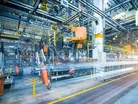The top five technology predictions for the manufacturing industry in 2020

It is no secret that the manufacturing sector is a significant contributor to the Australian economy, in particular sectors like food and beverage production, metal fabrication, as well as defence and aerospace. Manufacturing creates much-needed jobs and is a source of innovation, productivity and global trade for Australia. According to McKinsey, globally the sector now accounts for approximately 16 percent of GDP and 14 percent of jobs, whilst that figure is much lower in Australia at seven percent. This is because we have successfully shed ourselves of inefficient car and textile manufacturing, that will ultimately need to be replaced with advanced manufacturing in various sectors over the next few years.
The Australian manufacturing sector has also had to evolve rapidly to meet global needs and reinvent itself somewhat, whilst recovering from the global financial crisis and the mining boom and bust. McKinsey goes on to say that by 2025, a new global consuming class will have emerged, and the majority of consumption will take place in developing economies, in particular Asia Pacific, which represents a major opportunity for Australian manufacturers.
Many are viewing technology as the vital ingredient that manufacturers need to apply to their business to succeed. Here are my predictions for how technology will metamorphose manufacturing in the next few years.
1. The Augmentation of Human Ability
Artificial Intelligence (AI) is no longer just an industry catch phrase. According to the Accenture AI is the new UI report, despite scepticism of AI as just another technology buzzword, its momentum is very real. 85% of executives surveyed stated that they will invest extensively in AI-related technologies over the next three years. The report goes on to say that with AI in place, interactions with customers will move from straightforward transactional models to multidimensional conversations spanning a variety of complementary channels. Within the manufacturing sector, this could take the form of an AI chatbot.
This takes me to my first prediction – the rise of the augmentation of human ability. Chat bots or ‘digital citizens’ have enabled or augmented human ability by allowing manufacturing businesses to make decisions much faster. What is important is the fact that they chatbot is not replacing the human element in customer service, but rather adding value by offering customers a 24/7 touch point.
2. 5iR and the ‘digital opportunity’
By 2023, IDC predicts that the global economy will finally reach "digital supremacy" with more than half of all GDP worldwide driven by products and services from digitally transformed enterprises. The truth is that the digital revolution is inevitable, and it is vital to embrace the digital opportunity or face the risk of redundancy in a highly competitive world.
For the manufacturing sector, the fifth industrial revolution will require manufacturers to incorporate a level of artificial intelligence, managed infrastructure, advanced analytics and even robotics to remain relevant. Deloitte calls this Digital “muscle building”, where technology will allow manufacturers to connect and monitor every facet of their business. This is all while their ability to flex production, delivery, and customer support continues to be important.
SEE ALSO:
3. The Circular Economy and the evolution of sustainability
According to Nielsen’s recent global sustainability report, 81 percent of respondents feel strongly that companies should help improve the environment by implementing programs to this effect. There is also an appeal for the manufacturing sector to contribute to the global sustainability zeitgeist by opting into the ‘circular economy’.
The circular economy is a simple concept. It essentially refers to the reuse of resources and decrease of waste. Each product at end-of-life becomes a new resource rather than merely being discarded. It recognises the value of waste items, repurposing them as alternative resources that can be used again and again in a circular goods cycle.
For example, a plastics manufacturer could incorporate more recycled content in each packaging unit that they sell. Energy reduction is another bi-product of the circular economy and by reducing energy usage, the environment benefits from reduced air pollution. The increased intelligence technology provides can help decision makers, from planning the factory floor in a more efficient manner, buying more energy efficient machines to looking at implementing a full green initiative.
4. Advanced Food Tracking and Packaging
An article within the World Economic Forum site indicated that about 600 million people suffer food poisoning every year, according to the World Health Organisation, and 420,000 die as a result. When an outbreak occurs, investigators can spend days or weeks tracking its source. A good example is the strawberry needle contamination crisis in the Spring of 2018, that sparked a nationwide crisis and major product recalls across multiple supermarkets. It resulted in tonnes of strawberries being dumped or going to waste around Australia threatening the future of the half-a-billion-dollar industry. In response, Coles and Aldi pulled all strawberries from their shelves, while Woolworths only removed the affected brands it stocked.
Increasingly, technology is playing a more pivotal role in risk detection as opposed to disaster recovery. This is known as traceability, where technologies such as ERP allows manufacturers to meet the consumer demands for food transparency while enhancing the ability to identify, respond to and even prevent food safety issues.
5. Greater customer engagement
Despite continuous technological shifts, one element remains the same: the customer experience journey needs to be amazing. An important part of delivering a good customer experience is the reliance on interconnectivity and integrated workflows. This has been made possible with technologies such as SYSPRO Enterprise Resource Planning.
Ultimately, the manufacturing sector has seen constant growth and change with the introduction of new technologies ranging from AI to IoT. Customers are also calling for greater sustainability efforts, quicker response times and improved service levels. If every business decision is made with the customer in mind, technology can offer a digital opportunity for manufacturers to flourish in 2020 and beyond.
By Rob Stummer, CEO of Asia Pacific & Kevin Dherman, Chief Innovation Officer at SYSPRO



